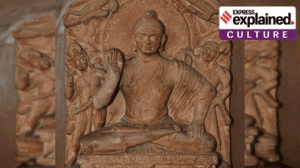TAG: GS 1: ART AND CULTURE
THE CONTEXT: The LoP in Lok Sabha, Mr Rahul Gandhi has frequently used the abhaya mudra, a gesture symbolizing reassurance and fearlessness, in various public appearances, including Congress rallies, the Bharat Jodo Yatra, and his speeches in Parliament.
EXPLANATION:
- In his first address as the LoP in Lok Sabha, Mr Rahul Gandhi invoked this gesture to convey a message of confronting fear and promoting a culture of fearlessness, which he claims is integral to Indian civilization and Hindu religion.
Historical and Philosophical Origins
- Meaning and Context in Buddhism
- In Sanskrit, the term ‘mudra’ can mean a seal, mark, sign, or currency.
- In the context of Buddhism, it refers to hand and arm gestures used during rituals or depicted in images of deities and enlightened beings.
- Mudras convey different moods and meanings, representing various states of realization and spiritual messages.
- Earliest Depictions:
- The earliest physical depictions of the Buddha date back to around the turn of the first millennium.
- Initially, the Buddha was symbolized by abstract representations like a vacant throne or a footprint.
- Physical depictions began to emerge in Gandhara art, influenced by Hellenistic styles, and later in the Gupta period in the Gangetic plains.
- Abhaya Mudra:
- One of the earliest and most significant mudras in Buddhist iconography is the abhaya mudra, or “gesture of fearlessness”.
- This gesture is typically formed with the palm of the right hand facing outward at shoulder height, fingers pointing up.
- In some instances, both hands may be raised in a double abhaya mudra.
- The abhaya mudra is associated with the Buddha immediately after his Enlightenment, symbolizing security, serenity, and compassion derived from Enlightenment.
- It is also linked to the Buddha’s ability to grant fearlessness, as depicted in the legend of the Buddha taming a wild elephant driven mad by his cousin Devadatta.

A sculpture of the Buddha from the Kushana period, currently in the Mathura Museum. The Buddha is depicted with the abhaya mudra
Symbolism in Hinduism
- The abhaya mudra also appears in Hindu iconography, representing similar themes of protection and fearlessness.
- Hindu Deities:
- Over time, the gesture was incorporated into depictions of Hindu deities, including Lord Shiva, Lord Vishnu, and Lord Ganesha.
- This adoption reflects the blending of various cultural and religious traditions within Hinduism.
- Buddha as Vishnu’s Avatar:
- The Buddha was integrated into the Hindu pantheon as the ninth avatar of Vishnu.
- This synthesis of traditions contributed to the widespread use of the abhaya mudra in Hindu art and religious practice.
Cultural and Political Usage
- In the speech of the LoP in Lok Sabha, Mr Rahul Gandhi, invoking the abhaya mudra to underscore his message of fearlessness in the face of what he described as a government regime based on fear.
- He emphasized that the culture of fear is alien to Indian civilization and the Hindu religion.
- By referencing the abhaya mudra, he connected his political stance with a deep-seated cultural and spiritual symbol of fearlessness and protection.
- By invoking the abhaya mudra, it is aimed to reassure the public and convey a message of resilience and defiance against fear.
- The gesture serves as a powerful visual symbol that resonates across various religious and cultural contexts in India.
Broader Implications
- Experts in religious studies and iconography provide additional insights into the significance and historical evolution of the abhaya mudra.
- Scholarly Perspectives: Scholars like Buswell and Lopez describe the abhaya mudra as a gesture of fearlessness and protection. It conveys a sense of security and compassion associated with Enlightenment and spiritual mastery.
- Cultural Fusion: The incorporation of the abhaya mudra into Hindu iconography reflects the dynamic interplay of religious and cultural influences in India. This fusion underscores the shared themes of protection and fearlessness that transcend specific religious boundaries.

